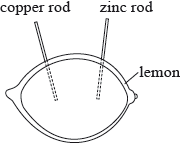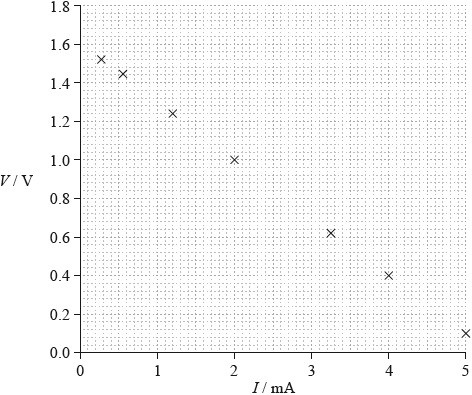| Date | May 2014 | Marks available | 6 | Reference code | 14M.2.SL.TZ2.6 |
| Level | Standard level | Paper | Paper 2 | Time zone | Time zone 2 |
| Command term | Calculate and Outline | Question number | 6 | Adapted from | N/A |
Question
This question is in two parts. Part 1 is about the motion of a car. Part 2 is about electricity.
Part 1 Motion of a car
A car is travelling along the straight horizontal road at its maximum speed of \({\text{56 m}}\,{{\text{s}}^{ - 1}}\). The power output required at the wheels is 0.13 MW.
A driver moves the car in a horizontal circular path of radius 200 m. Each of the four tyres will not grip the road if the frictional force between a tyre and the road becomes less than 1500 N.
Part 2 Electricity
A lemon can be used to make an electric cell by pushing a copper rod and a zinc rod into the lemon.

A student constructs a lemon cell and connects it in an electrical circuit with a variable resistor. The student measures the potential difference V across the lemon and the current I in the lemon.
A car accelerates uniformly along a straight horizontal road from an initial speed of \({\text{12 m}}\,{{\text{s}}^{ - 1}}\) to a final speed of \({\text{28 m}}\,{{\text{s}}^{ - 1}}\) in a distance of 250 m. The mass of the car is 1200 kg. Determine the rate at which the engine is supplying kinetic energy to the car as it accelerates.
A car is travelling along a straight horizontal road at its maximum speed of \({\text{56 m}}\,{{\text{s}}^{ - 1}}\). The power output required at the wheels is 0.13 MW.
(i) Calculate the total resistive force acting on the car when it is travelling at a constant speed of \({\text{56 m}}\,{{\text{s}}^{ - 1}}\).
(ii) The mass of the car is 1200 kg. The resistive force \(F\) is related to the speed \(v\) by \(F \propto {v^2}\). Using your answer to (b)(i), determine the maximum theoretical acceleration of the car at a speed of \({\text{28 m}}\,{{\text{s}}^{ - 1}}\).
(i) Calculate the maximum speed of the car at which it can continue to move in the circular path. Assume that the radius of the path is the same for each tyre.
(ii) While the car is travelling around the circle, the people in the car have the sensation that they are being thrown outwards. Outline how Newton’s first law of motion accounts for this sensation.
(i) Draw a circuit diagram of the experimental arrangement that will enable the student to collect the data for the graph.
(ii) Show that the potential difference \(V\) across the lemon is given by
\[V = E - Ir\]
where \(E\) is the emf of the lemon cell and \(r\) is the internal resistance of the lemon cell.
(iii) The graph shows how \(V\) varies with \(I\).

Using the graph, estimate the emf of the lemon cell.
(iv) Determine the internal resistance of the lemon cell.
(v) The lemon cell is used to supply energy to a digital clock that requires a current of \({\text{6.0 }}\mu {\text{A}}\). The clock runs for 16 hours. Calculate the charge that flows through the clock in this time.
Markscheme
use of a kinematic equation to determine motion time \(( = 12.5{\text{ s)}}\);
change in kinetic energy \( = \frac{1}{2} \times 1200 \times \left[ {{{28}^2} - {{12}^2}} \right]{\text{ }}( = 384{\text{ kJ)}}\);
rate of change in kinetic energy \( = \frac{{384000}}{{12.5}}\); } (allow ECF of 162 from (28 – 12)2 for this mark)
31 (kW);
or
use of a kinematic equation to determine motion time \(( = 12.5{\text{ s)}}\);
use of a kinematic equation to determine acceleration \(( = {\text{1.28 m}}\,{{\text{s}}^{ - 2}}{\text{)}}\);
work done \( = \frac{{F \times s}}{{{\text{time}}}} = \frac{{1536 \times 250}}{{12.5}}\);
31 (kW);
(i) \({\text{force}} = \frac{{{\text{power}}}}{{{\text{speed}}}}\);
2300 or 2.3k (N);
Award [2] for a bald correct answer.
(ii) resistive force \( = \frac{{2300}}{4}\)\(\,\,\,\)or\(\,\,\,\)\(\frac{{2321}}{4}{\text{ }}( = 575)\); (allow ECF)
so accelerating force = \((2300 - 580 = ){\text{ }}1725{\text{ (N)}}\)\(\,\,\,\)or\(\,\,\,\)1741 (N);
\(a = \frac{{1725}}{{1200}} = 1.44{\text{ (m}}{{\text{s}}^{ - 2}}{\text{)}}\)\(\,\,\,\)or\(\,\,\,\)\(a = \frac{{1741}}{{1200}} = 1.45{\text{ (m}}\,{{\text{s}}^{ - 2}}{\text{)}}\);
Award [2 max] for an answer of 0.49 (m\(\,\)s–2) (omits 2300 N).
(i) centripetal force must be \( < {\text{6000 (N)}}\); (allow force = 6000 N)
\({v^2} = F \times \frac{r}{m}\);
\({\text{31.6 (m}}\,{{\text{s}}^{ - 1}}{\text{)}}\);
Allow [3] for a bald correct answer.
Allow [2 max] if 4\( \times \) is omitted, giving 15.8 (m\(\,\)s–1).
(ii) statement of Newton’s first law;
(hence) without car wall/restraint/friction at seat, the people in the car would move in a straight line/at a tangent to circle;
(hence) seat/seat belt/door exerts centripetal force;
(in frame of reference of the people) straight ahead movement is interpreted as “outwards”;
(i) voltmeter in parallel with cell; (allow ammeter within voltmeter leads)
ammeter in series with variable resistor; } (must draw as variable arrangement or as potential divider)
Allow cell symbol for lemon/cell/box labelled “lemon cell”.
Award [1 max] if additional cell appears in the circuit.
(ii) \(E = I(R + r)\) and \(V = IR\) used; (must state both explicitly)
re-arrangement correct ie \(E = V + Ir\); } (accept any other correct re-arrangement eg. involving energy conversion)
(iii) line correctly extrapolated to y-axis; (judge by eye)
1.6 or 1.60 (V); (allow ECF from incorrect extrapolation)
(iv) correct read-offs from large triangle greater than half line length;
gradient determined;
290 to 310 \({\text{(}}\Omega {\text{)}}\);
Award [2 max] for the use of one point on line and equation.
(v) 0.35 (C);
Examiners report
There were at least two routes to tackle this problem. Some solutions were so confused that it was difficult to decide which method had been used. Common errors included: forgetting that the initial speed was \({\text{12 m}}\,{{\text{s}}^{ - 1}}\) not zero, power of ten errors, and simple mistakes in the use of the kinematic equations, or failure to evaluate work done = force \( \times \) distance correctly. However, many candidates scored partial credit. Scores of two or three out of the maximum four were common showing that many are persevering to get as far as they can.
(i) Many correct solutions were seen. Candidates are clearly comfortable with the use of the equation force = power/speed.
(ii) The method to be used here was obvious to many. What was missing was a clear appreciation of what was happening in terms of resistive force in the system. Many scored two out of three because they indicated a sensible method but did not use the correct value for the force. Scoring two marks does require that the explanation of the method is at least competent. Those candidates who give limited explanations of their method leading to a wrong answer will generally accumulate little credit. A suggestion (never seen in answers) is that candidates should have begun from a free-body force diagram which would have revealed the relationship of all the forces.
(i) The major problem here was that most candidates did not recognise that 1500 N of force acting at each of four wheels will imply a total force of 6 kN. Again, partial credit was available only if it was clear what the candidate was doing and what the error was.
(ii) Statements of Newton’s first law were surprisingly poor. As in previous examinations, few candidates appear to have learnt this essential rule by heart and they produce a garbled and incomplete version under examination pressure. The first law was then only loosely connected to the particular context of the question. Candidates have apparently not learnt to relate the physics they learn to everyday contexts.
(i) Circuit diagrams continue to be a particular issue for many candidates. Neat, well-drawn diagrams are rarely seen. Some diagrams had two cells, the lemon cell and another. Variable resistors were sometimes absent (or were drawn as fixed). Potential dividers were often attempted usually unsuccessfully. Generally candidates gained an average one mark for what should have been a familiar task.
(ii) Those who quoted the data booklet equation and the definition of resistance were generally able to show the final expression. Some however could not convince the examiners that they knew what they were doing.
(iii) Candidates were expected to understand the physical point that the emf can be determined when the current in the cell is zero. For many, an extrapolation of the obvious straight line to the emf axis and a correct read-off gave an easy couple of marks. Some however did not understand the physics of the circuit and gave poorly described solutions.
(iv) The internal resistance was best obtained from a large triangle drawn on the graph. Many however gained two of the three marks because they engendered power of ten errors or because they used only one point, or because their triangle was too small.
(v) Only a minority were able to use the data to calculate the charge transferred correctly.

